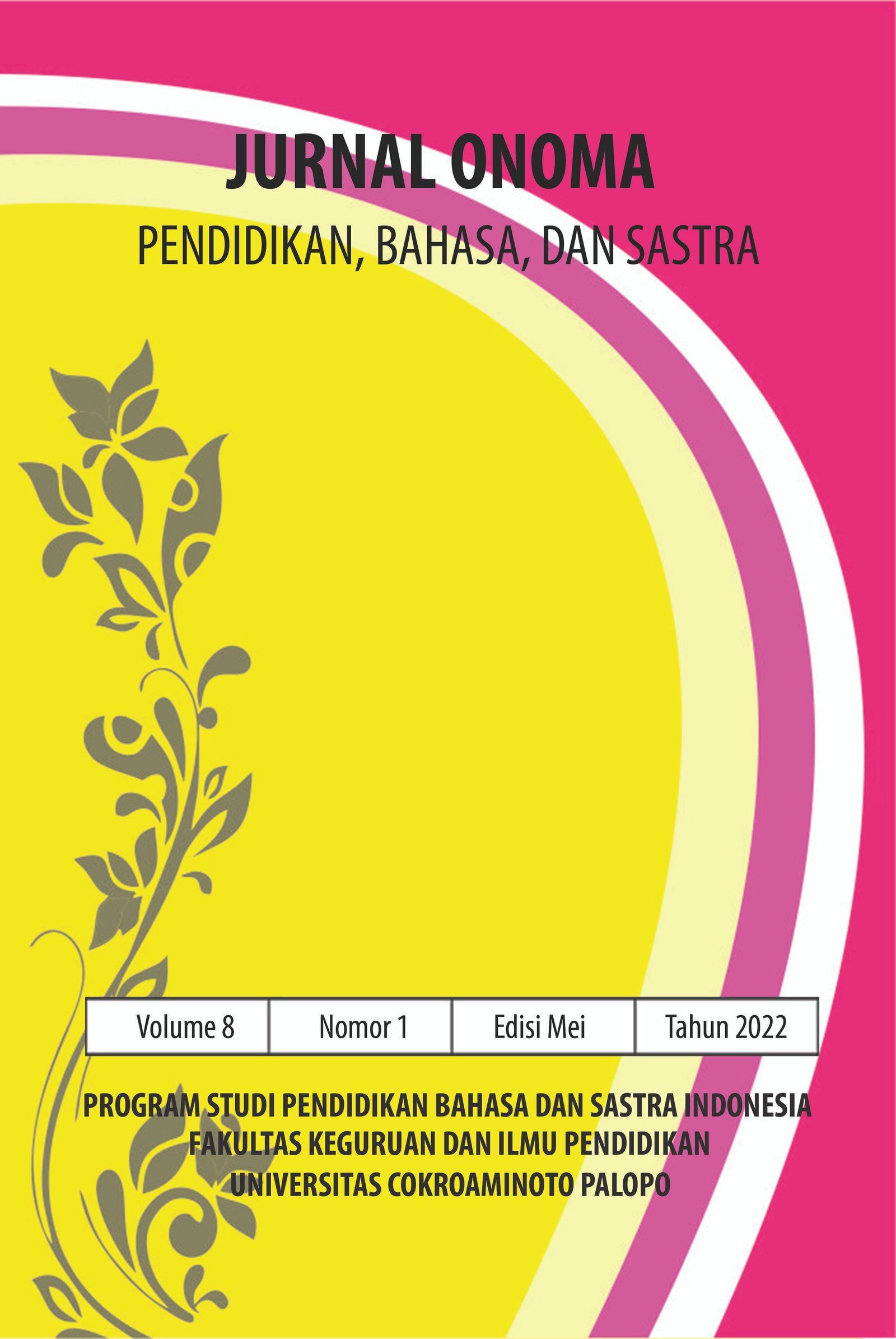Defense Mechanism as a Strategy to Overcome Jacob's Anxiety in William Landay's Defending Jacob
https://doi.org/10.30605/onoma.v8i1.1730
Keywords:
defense mechanism, anxiety, psychoanalysisAbstract
Defense mechanism is a strategy or effort developed by the ego to dispel unpleasant feelings caused by anxiety so that unpleasant feelings and experiences feel better. The purpose of the study are to reveal the type of anxiety experienced by Jacob Barber in William Landay's Defending Jacob and discover how defense mechanisms work to overcome this anxiety. The method used in this study is qualitative by applying Sigmund Freud's anxiety and defense mechanism theory in a psychoanalytic approach. The data in this study are in the form of phrases, sentences, and dialogues contained in the novel Defending Jacob written by William Landay. The results of this study indicate that there are three types of anxiety experienced by Jacob Barber. They are neurotic, moral, and realistic anxiety. In order to overcome these anxiety, Jacob Barber uses five types of defense mechanisms, namely denial, projection, displacement, rationalization, and reaction formation. The types of defense mechanisms that are most often used to overcome the anxiety that arise in Jacob Barber are projection and displacement.
Downloads
References
Baker, C. (2020). Mental Health Statistics for England : Prevalence , Services and Funding. 6988.
Bilgiç, A., Yilmaz, S., & Hergüner, S. (2017). The Impact of Anxiety Sensitivity on Suicidality in Adolescents with Major Depressive Disorder. Psychiatria Danubina, 29(4), 473–479. https://doi.org/10.24869/psyd.2017.473
Boeree, C. G. (2006). Personality Theories. In Routledge Handbook of Psychoanalytic Political Theory. https://doi.org/10.4324/9781315524771-2
Drever, J. (1983). A Dictionary of Psychology. Penguin Books.
Feist, J., Feist, G. J., & Tomi-Ann, R. (2018). Theories of Personality. In McGraw-Hill Education. https://mheducation.com/highered
Freud, A. (2018). The Ego and the Mechanisms of Defence. Taylor and Francis.
Freud, S. (2021). A General Introduction to Psychoanalysis (Graphyco E).
Freud, S., & Sprott, W. J. H. (Walter J. H. (2013). New Introductory Lectures on Psycho-analysis. Martino Publishing.
Khoirunisa, N., & Rahayu, E. Y. (2020). Ego Defense Mechanism of the Main Female Characters in Maleficient Movie. Dinamika Bahasa Dan Budaya, 15.
Landay, W. (2020). Defending Jacob. Bantam Books US.
Lee, C. W., Lee, J., Jun, J. Y., Lee, S. H., Yu, S. Y., Park, J., & Kim, S. J. (2021). Associations between Defense Mechanisms and Life Satisfaction among North Korean Refugees. Annals of General Psychiatry, 20(1), 1–7. https://doi.org/10.1186/s12991-021-00339-1
Minderop, A. (2008). Psikologi Sastra: Karya Sastra, Metode, Teori, dan Contoh Kasus. Yayasan Pustaka Obor Indonesia.
Nevid, J. S., Rathus, S. A., & Greene, B. (2021). Abnormal psychology in a changing world (Eleventh). Pearson.
Pradopo, R. D. (2007). Prinsip-prinsip Kritik Sastra: Teori dan Penerapannya. Gadjah Mada University Press.
Purqoti, N. S. D., Rusiana, H. P., Oktaviana, E., Ernawati, & Rispawati, B. H. (2021). The Relationship Between Psychological Adaptation and Anxiety Level in the New Normal Era at Central Lombok. Strada Jurnal Ilmiah Kesehatan, 10(1), 679–688. https://doi.org/10.30994/sjik.v10i1.688
Schultz, D. P. (2009). Theories of Personality (9th ed.). Cengage Learning.
Spielberger, C. D. (2014). Anxiety and Behavior. Elsevier Science.
Stuart, G. W. (2014). Principles and Practice of Psychiatric Nursing (10th ed.). Mosby.
Sudwintari, & Wulan, S. (2019). Destiny of Injustice in William Landay’s Novel Defending Jacob. Journal of Language, 1.
Suparman, S., & Charmilasari, C. (2017). Analysis of Phase Structure Realization in Classroom Discourse: A Study of Systemic Functional Linguistics. Ethical Lingua: Journal of Language Teaching and Literature, 4(2), 120-126.
Suparman, S. (2014). Prosesi Ritual Pascapemakaman Masyarakat Tangru Kecamatan Malua Kabupaten Enrekang. Prosiding, 1(1), 163-167.
Van Ameringen, M., Mancini, C., & Farvolden, P. (2003). The Impact of Anxiety Disorders on Educational Achievement. Journal of Anxiety Disorders, 17(5), 561–571. https://doi.org/10.1016/S0887-6185(02)00228-1
Zulfaisya, R., & Hasra, H. (2020). Defense Mechanism of the Main Character in Laurie Halse Anderson’S Speak Novel. BAHTERA : Jurnal Pendidikan Bahasa Dan Sastra, 19(2), 313–335. https://doi.org/10.21009/bahtera.192.08
Downloads
Published
How to Cite
License
In submitting the manuscript to the journal, the authors certify that:
- They are authorized by their co-authors to enter into these arrangements.
- The work described has not been formally published before, except in the form of an abstract or as part of a published lecture, review, thesis, or overlay journal.
- That it is not under consideration for publication elsewhere,
- That its publication has been approved by all the author(s) and by the responsible authorities – tacitly or explicitly – of the institutes where the work has been carried out.
- They secure the right to reproduce any material that has already been published or copyrighted elsewhere.
- They agree to the following license and copyright agreement.
License and Copyright Agreement
Authors who publish with Onoma Journal: Education, Languages??, and Literature agree to the following terms:
- Authors retain copyright and grant the journal right of first publication with the work simultaneously licensed under Creative Commons Attribution License (CC BY 4.0) that allows others to share the work with an acknowledgment of the work's authorship and initial publication in this journal.
- Authors are able to enter into separate, additional contractual arrangements for the non-exclusive distribution of the journal's published version of the work (e.g., post it to an institutional repository or publish it in a book), with an acknowledgment of its initial publication in this journal.
- Authors are permitted and encouraged to post their work online (e.g., in institutional repositories or on their website) prior to and during the submission process, as it can lead to productive exchanges, as well as earlier and greater citation of published work.

















